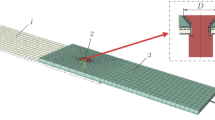An experimental batch of connecting M12 bolts for aerospace application was produced by the method of rapid heat treatment with hot heading from the rods of VT22 alloy obtained as a result of intense hot plastic deformation (step-by-step forging and rolling). After final aging in the course of tensile tests, the bolts had the following characteristics: the yield and ultimate strengths equal to 1380 and 1455 МРа, respectively, a relative elongation of 7.2%, and a relative narrowing of 24.3%. The tests carried out according to the program developed at the “ANTONOV” State Enterprise showed that the fatigue and low-cycle fatigue are almost two times higher in the case of thread rolling performed in the completely thermally hardened state, i.e., after final aging. We also established the possibility of enhancement of the fatigue characteristics of the bolts by improving the technology of mechanical treatment.





Similar content being viewed by others
References
O. M. Ivasishin, P. E. Markovsky, Yu. V. Matviychuk, et al., “A comparative study of the mechanical properties of high-strength beta-titanium alloys,” J. Alloys Compounds, 457, Nos. 1–2, 296–309 (2008).
O. M. Ivasishin, P. E. Markovsky, S. L. Semiatin, and C. H. Ward, “Aging response of coarse- and fine-grained beta-titanium alloys,” Mater. Sci. Eng. A, 405, Nos. 1–2, 296–305 (2005).
S. G. Glazunov and V. N. Moiseev, Structural Titanium Alloys [in Russian], Metallurgiya, Moscow (1969).
O. M. Ivasyshyn, P. E. Markovs’kyi, I. M. Havrysh, and O. P. Karasevs’ka, “Influence of cooling rate in the process of hardening on the aging and formation of the mechanical characteristics of VT22 titanium alloy,” Fiz.-Khim. Mekh. Mater., 50, No. 1, 60–66 (2014); English translation: Mater. Sci., 50, No. 1, 62–69 (2014).
O. M. Ivasishin, P. E. Markovskii, A. G. Molyar, et al., “High-strength mounting hardware of VT22 alloy,” in: Proc. of the Tenth Internat. Conf. “Ti–2012 in the Commonwealth of Independent States” (April 22–25, 2012, Kazan, Russia) [in Russian], Kurdyumov Institute for Metal Physics, Kyiv (2012), pp. 39–44.
O. M. Ivasishin, P. E. Markovskii, A. G. Molyar, et al., “Optimization of the mechanical properties of rod semifinished products of VT22 alloy by special thermomechanical treatment,” in: Proc. of the Tenth Internat. Conf. “Ti–2012 in the Commonwealth of Independent States” (April 22–25, 2012, Kazan, Russia) [in Russian], Kurdyumov Institute for Metal Physics, Kyiv (2012), pp. 102–107.
O. M. Ivasishin, P. E. Markovsky, M. Pozuelo, and S. V. Prikhodko, “Effect of severe hot forging and rolling on microstructure, texture, and tensile properties of titanium metastable beta-alloys,” in: Proc. of the ASME 2013 Internat. Mech. Eng. Congr. and Exposition IMECE13 (November 15–21, 2013, San Diego, California, USA), Paper No. IMECE2013-63767 (2013).
O. M. Ivasishin, P. E. Markovsky, M. Pozuelo, and S. V. Prikhodko, “Unique recrystallization resistance of titanium metastable β-alloys under severe hot deformation,” Microsc. Microanal., 19, Suppl. S2, 1776–1777 (2013).
Author information
Authors and Affiliations
Corresponding author
Additional information
Translated from Fizyko-Khimichna Mekhanika Materialiv, Vol. 51, No. 3, pp. 62–67, May–June, 2015.
Rights and permissions
About this article
Cite this article
Ivasyshyn, О.М., Vasylevs’kyi, E.T., Antonyuk, S.L. et al. Specific Features of Fracture of High-Strength Bolts of VT22 Alloy. Mater Sci 51, 366–371 (2015). https://doi.org/10.1007/s11003-015-9850-8
Received:
Published:
Issue Date:
DOI: https://doi.org/10.1007/s11003-015-9850-8




